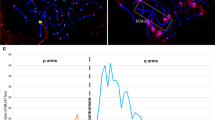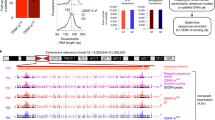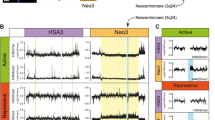Abstract
We have localized the DNA sequences required for mitotic centromere function on the human Y chromosome. Analysis of 33 rearranged Y chromosomes allowed the centromere to be placed in interval 8 of a 24–interval deletion map. Although this interval is polymorphic in size, it can be as small as ∼500kb. It contains alphoid satellite DNA and ∼300kb of adjacent Yp sequences. Chromosomes with rearrangements in this region were analysed in detail. Two translocation chromosomes and one monocentric isochromosome had breakpoints within the alphoid array. Of 12 suppressed Y centromeres on translocation chromosomes and dicentric isochromosomes that were also analysed two showed deletions one of which only removed alphoid DNA. These results indicate that alphoid DNA is a functional part of the Y chromosome centromere.
This is a preview of subscription content, access via your institution
Access options
Subscribe to this journal
Receive 12 print issues and online access
$209.00 per year
only $17.42 per issue
Buy this article
- Purchase on Springer Link
- Instant access to full article PDF
Prices may be subject to local taxes which are calculated during checkout
Similar content being viewed by others
References
Murray, A.W & Szostak,, J.W. Construction of artificial chromosomes in yeast. Nature 305, 189–193 (1983).
Hahnenberger, K.M., Baum, M.P., Polizzi, C.M., Carbon, J. & Clarke, L. Construction of functional artificial minichromosomes in the fission yeast Schizosaccharomyces pombe. Proc. natn. Acad. Sci. U.S.A. 86, 577–581 (1989).
Farr, C., Fantes, J., Goodfellow, P. & Cooke, H. Functional reintroduction of human telomeres into mammalian cells. Proc. natn. Acad. Sci. U.S.A. 88, 7006–7010 (1991).
Barnett, M.A. et al. Telomere directed fragmentation of mammalian chromosomes. Nucl. Acids Res. 21, 27–36 (1993).
Heinzel, S.S., Krysan, P.J., Tran, C.T. & Calos, M.P. Autonomous DNA replication in human cells is affected by the size and the source of the DNA. Molec. cell. Biol. 11, 2263–2272 (1991).
Clarke, L. & Carbon, J. Isolation of a yeast centromere and construction of functional small circular chromosomes. Nature 287, 504–509 (1980).
Niwa, O., Matsumoto, T. & Yanagida, M. Construction of a mini-chromosome by deletion and its mitotic and meiotic behavior in fission yeast. Molec. Gen. Genet. 203, 397–405 (1986).
Niwa, O., Matsumoto, T., Chikashige, Y. & Yanagida, M. Characterization of Schizosaccharomyces pombe minichromosome deletion derivatives and a functional allocation of their centromere. EMBO J. 8, 3045–3052 (1989).
Tyler-Smith, C. & Brown, W.R.A. Structure of the major block of alphoid satellite DNA on the human Y chromosome. J. molec. Biol. 195, 457–470 (1987).
Cooper, K.F., Fisher, R.B. & Tyler-Smith, C. Structure of the pericentric long arm region of the human Y chromosome. J. molec. Biol. 228, 421–432 (1992).
Cooper, K.F., Fisher, R.B. & Tyler-Smith, C. Structure of the sequences adjacent to the centromeric alphoid satellite DNA array on the human Y chromosome. J. molec. Biol. 230, 787–799 (1993).
Foote, S., Vollrath, D., Hilton, A. & Page, D.C. The human Y chromosome: overlapping DNA clones spanning the euchromatic region. Science 258, 60–66 (1992).
Haaf, T., Warburton, P.E. & Willard, H.F. Integration of human α-satellite DNA into simian chromosomes: centromere protein binding and disruption of normal chromosome segregation. Cell 70, 681–696 (1992).
Grady, D.L. et al. Highly conserved repetitive DNA sequences are present at human centromeres. Proc. natn. Acad. Sci. U.S.A. 89, 1695–1699 (1992).
Hadlaczky, G. et al. Centromere formation in mouse eel Is cotransformed with human DNA and a dominant marker gene. Proc. natn. Acad. Sci. U.S.A. 88, 8106–8110 (1991).
Cooper, K.F. & Tyler-Smith, C. The putative centromere-forming sequence λCM8 is a single copy sequence and is not a component of most human centromeres. Hum. molec. Genet. 1, 753–754 (1992).
Oakey, R. & Tyler-Smith, C. Y chromosome DNA haplotyping suggests that most European and Asian men are descended from one of two males. Genomics 7, 325–330 (1990).
Emrie, P.A., Jones, C., Hofmann, T. & Fisher, J.H. The coding sequence for the human 18,000-dalton hydrophobic pulmonary surfactant protein is located on chromosome 2 and identifies a restriction fragment length polymorphism. Somatic Cell molec. Gen. 14, 105–110 (1988).
Moyzis, R.K. et al. A highly conserved repetitive DNA sequence, (TTAGGG)n, present at the telomeres of human chromosomes. Proc. natn. Acad. Sci. U.S.A. 85, 6622–6626 (1988).
Münke, M. et al. Molecular detection of a Yp/18 translocation in a 45, X holoprosencephalic male. Hum. Genet. 80, 219–223 (1988).
Affara, N.A. et al. Regional assignment of Y-linked DNA probes by deletion mapping and their homology with X-chromosome and autosomal sequences. Nucl. Acids Res. 14, 5353–5373 (1986).
Maraschio, P. et al. Deletion of specific sequences or modification of centromeric chromatin are responsible for Y chromosome centromere inactivation. Hum. Genet. 85, 491–494 (1990).
Smith, G.P. Evolution of repeated DNA sequences by unequal crossover. Science 191, 528–535 (1976).
Crolla, J.A., Dennis, N.R. & Jacobs, P.A. A non-isotopic in situ hybridisation study of the chromosomal origin of 15 supernumerary marker chromosomes in man. J. med. Genet. 29, 699–703 (1992).
Rauch, A. et al. A study of ten small supernumerary (marker) chromosomes identified by fluorescence in situ hybridization (FISH). Clin. Genet. 42, 84–90 (1992).
Voullaire, L.E., Slater, H.R., Petrovic, V. & Choo, K.H.A. A functional marker centromere with no detectable alpha-satellite, satellite III, or CENP-B protein: activation of a latent centromere? Am. J. hum. Genet. 52, 1153–1163 (1993).
Mann, C. & Davis, R.W. Instability of dicentric plasmids in yeast. Proc. natn. Acad. Sci. U.S.A. 80, 228–232 (1983).
Koshland, D., Rutledge, L., Fitzgerald-Hayes, M. & Hartwell, L.H. A genetic analysis of dicentric minichromosomes in Saccharomyces cerevisiae. Cell 48, 801–812 (1987).
Jäger, D. & Philippsen, P. Stabilization of dicentric chromosomes in Saccharomyces cerevisiae by telomere addition to broken ends or by centromere deletion. EMBO J. 8, 247–254 (1989).
Maserati, E. et al. A 45, X male with a Yp/18 translocation. Hum. Genet. 74, 126–132 (1986).
Nakahori, Y., Mitani, K., Yamada, M. & Nakagome, Y. A human Y-chromosome specific repeated DNA family (DYZ1) consists of a tandem array of pentanucleotides. Nucl. Acids Res. 14, 7569–7580 (1986).
Affara, N.A. et al. Mapping the testis determinants by an analysis of Y-specific sequences in males with apparent XX and XO karyotypes and females with XY karyotypes. Nucl. Acids Res. 15, 7325–7342 (1987).
Chandley, A.C. et al. Deleted Yq in the sterile son of a man with a satellited Y chromosome (Yqs). J. med. Genet. 26, 145–153 (1989).
Chandley, A.C. et al. Short arm dicentric Y chromosome with associated statural defects in a sterile man Hum. Genet. 73, 350–353 (1986).
O'Reilly, A.J. et al. A molecular deletion map of the Y chromosome long arm defining X and autosomal homologous regions and the localisation of the HYA locus to the proximal region of the Yq euchromatin. Hum. molec. Genet. 1, 379–385 (1992).
Chandley, A.C. & Edmond, P. Meiotic studies on a subfertile patient with a ring Y chromosome. Cytogenetics 10, 295–304 (1971).
Petrovic, V. et al. Minute Y chromosome derived marker in a child with gonadoblastoma: cytogenetic and DNA studies. J. med. Genet. 29, 542–546 (1992).
Müller, U., Kirkels, V.G.H.J. & Scheres, J.M.J. Absence of Turner stigmata in a 46,XYp–female. Hum. Genet. 90, 239–242 (1992).
Author information
Authors and Affiliations
Rights and permissions
About this article
Cite this article
Tyler-Smith, C., Oakey, R., Larin, Z. et al. Localization of DNA sequences required for human centromere function through an analysis of rearranged Y chromosomes. Nat Genet 5, 368–375 (1993). https://doi.org/10.1038/ng1293-368
Received:
Accepted:
Issue Date:
DOI: https://doi.org/10.1038/ng1293-368
This article is cited by
-
Identification and diversity of functional centromere satellites in the wild rice species Oryza brachyantha
Chromosome Research (2013)
-
CENP-A: the key player behind centromere identity, propagation, and kinetochore assembly
Chromosoma (2012)
-
Human centromere genomics: now it's personal
Chromosome Research (2012)
-
Short Oligonucleotide Tandem Ligation Assay for Genotyping of Single-Nucleotide Polymorphisms in Y Chromosome
Molecular Biotechnology (2010)
-
Artificial chromosome formation in maize (Zea mays L.)
Chromosoma (2009)



